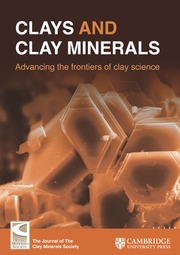No CrossRef data available.
Article contents
Low-cost membrane supports for wastewater treatment made from local clay and calcite mixtures
Published online by Cambridge University Press: 22 August 2025
Abstract
Wastewater treatment is critically important and ceramic-membrane engineering is one of the most effective technologies for water filtration and purification. However, the materials used in the preparation of ceramic membranes are usually expensive, e.g. ZrO and Al2O3 membranes, reverse osmosis materials such as carbon-based thin-film nanocomposite TFNC ‘carbon nanotube, graphene-oxide’. Delicate, thin membranes employed for small-scale filtration usually require optimal supports for effective operation. The purpose of the present research, therefore, was to find a less expensive material for membrane supports while, at the same time, enhancing performance. Membrane supports were thus prepared from local clay materials and (25 wt.%) CaCO3 using an extrusion technique, which enabled the production of tubular supports. The CaCO3 is responsible for creating the pores in the samples during heat treatment due to the evolution of CO2 gas. Some characteristics of the supports were evaluated using X-ray diffraction, which identified quartz, gehlenite, sillimanite, H-bearing aluminous stishovite, and wollastonite. The support treated at 1000°C displayed significant mechanical properties (flexural strength, 11.58 MPa, measured using three-point bending tests) compared with supports treated at other temperatures. Moreover, the support sintered at 1000°C had an estimated permeability factor of 1052 L/h m2.bar after performing both time- and pressure-dependent flux measurements. Such properties make it possible to use these supports as multi-scale filtration membranes for purification and filtration applications after performing a standard filtration application on dirty water, resulting in a significant difference in terms of turbidity and waste content.
Information
- Type
- Original Paper
- Information
- Copyright
- © The Author(s), 2025. Published by Cambridge University Press on behalf of The Clay Minerals Society


